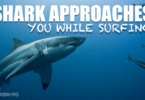One of the ocean’s most enigmatic and feared species is the great white shark – with rows of sharp teeth and razor-sharp edges, it has been the subject of countless stories. Movies like “Jaws” cemented their image as vicious man-eaters, hiding underwater, ready to strike at any moment. But one thought that often pops up in our minds is, do white sharks attack humans? In this article we will explore the complex relationship between great white sharks and humans, exploring their behavior, motivations, and the realities behind their interactions.
What Are White Sharks?
White sharks are found in the open waters worldwide, especially in warm coastal waters. Their huge size and strong, unique hindwings are well-known characteristics. Great white sharks reach a length of 20 feet and weigh around 2,000 pounds.
They are excellent at grabbing and gripping their prey because they have hundreds of rows of teeth. One of the most adept marine hunters, they excel at swimming and possess powerful bodies, sharp senses, and speed. These sharks are top predators in the marine food web, feeding mostly on different fish species, sea lions, and fish themselves.
Do White Sharks Attack Humans?
White shark attacks on marine creatures and, to a lesser extent, humans have given them a terrifying reputation. It’s crucial to realize that attacks and most encounters with white sharks don’t result in severe damage to humans. Only approximately 80 unprovoked shark attacks occur globally on average each year, and few humans are killed.
The majority of these attacks are best defined as “hit and run” instances. Due to their forms and movements, great white sharks are sometimes mistaken for their natural food, such as seals or sea lions. While these events can be dangerous, they are rarely fatal, due to sharks’ preference for marine mammals that are rich in nutrients.
What stimulates White Sharks to Attack Humans?
Rare great white shark attacks on humans are caused by several factors:
Mistaken Identity: Most attacks are due to their ability to not be able to distinguish between a human and its specific prey but when they realize the mistake, they generally leave the area.
Population Encounter: Great white sharks inhabit large areas of the ocean, and humans spend only a fraction of their time in these areas. Limited habitat overlaps between humans and sharks which reduces the likelihood of encounters.
Shark Behavior: Great white sharks are generally curious creatures and may approach floating boats or objects in the water to investigate. However, this curiosity does not necessarily translate into violence against humanity.
Feeding Behavior: White sharks eat primarily marine mammals, but there have been cases where they have attacked humans for possible capture. However, these cases are extremely rare and tend to occur in areas where natural resources are scarce for predators.
Human Activity: Human activities in white shark habitats can inadvertently increase the risk of encounter and attack. Activities such as fishing, kayaking, and swimming can increase the chances of an encounter near seal colonies or areas rich in marine life.
How to Minimize the Risk of White Shark Encounter?
If you plan to spend time in areas where white sharks are known to live, steps to reduce the risk of encounters and encourage coexistence include:
Respect Local Laws: Know what laws or guidelines apply to white shark encounters in your destination. Follow them closely to protect yourself and the sharks.
Avoid Seal Colonies: Avoid swimming or water activities near seal colonies because they are the primary food source for white sharks, especially during the breeding season.
Stay In Groups: Stay in groups when swimming or surfing. Dogs tend to approach solitary individuals.
Use Deterrents: Consider using deterrents and technology that can help reduce the likelihood of a shark encounter.
Be Informed: Educate yourself about local marine life, including white sharks, and their behavior.
Conclusion
While the image of a great white shark attacking a human is certainly terrifying, it’s important to separate fact from fiction. These top predators rarely target humans intentionally, and most incidents are due to factors such as misidentification, behavioral requirements, or rare coincidences in catching and eating animals. By understanding their behavior, taking precautions, and respecting their habitat, we can live with these magnificent creatures and appreciate the vital role they play in the balance of our oceans.







